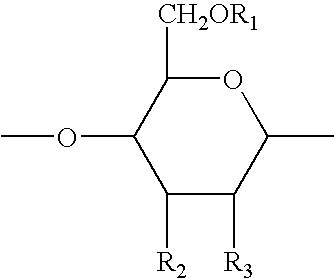Bacterial attachment reduction to biomaterials and biomedical devices
a biomaterial and biomedical technology, applied in the preparation of detergent mixtures, cleaning compositions, detergent compounding agents, etc., can solve the problems of increasing the bacterial load on the lens, forming biofilm residues on the lens, and the extent to which different microorganisms will attach to a specific biomaterial or device is difficult to predi
- Summary
- Abstract
- Description
- Claims
- Application Information
AI Technical Summary
Benefits of technology
Problems solved by technology
Method used
Image
Examples
example 1
[0101] This example illustrates the binding effect of the polyether onto hydrophilic contact lenses so to reduce attachment of bacteria to the contact lens surface.
[0102] Treatment of Contact Lenses
[0103] Twenty-ml aliquots of polyether-containing solutions were poured into sterile polystyrene disposable petri dishes. Group III extended wear contact lenses (Purevision™, Bausch & Lomb Incorporated, made of a silicone hydrogel material and having an anionic charge) were removed from their packages with a sterile forceps and immersed five times in 180 ml of initially sterile 0.9% saline. These lenses were then placed into the petri dishes containing polyether-containing solutions and soaked for 4 hours at room temperature. After the 4 hour incubation time, the lenses were removed from the polyether-containing solutions with a sterile forceps and immersed 5 respective times in each of three successive changes (180 ml) of initially sterile 0.9% saline. The lenses were then transferred ...
example 2
[0112] Contact lens samples were treated in a manner similar to Example. In this Example, the treatment solutions were reverse poloxamers, as listed in Table 2.
TABLE 2LOG REDUCTIONTreatment1%3%5%10%17 R 41.59E5 + 1.36E41.64E5 + 1.22E41.47E5 + 2.43E41.94E5 + 1.52E417 R 21.41E5 + 2.16E41.28E5 + 2.08E41.32E5 + 2.85E41.44E5 + 1.30E410 R 51.91E5 + 2.00E41.70E5 + 2.67E41.89E5 + 3.43E41.47E5 + 3.10E4PBS Control1.94E5 + 5.33E425 R 22.23E4 + 3.45E31.76E4 + 3.64E31.85E4 + 3.94E33.32E4 + 1.39E425 R 42.15E4 + 3.87E32.24E4 + 2.91E32.04E4 + 3.20E31.83E4 + 2.41E3PBS Control2.25E4 + 5.04E3
PUM
| Property | Measurement | Unit |
|---|---|---|
| water content | aaaaa | aaaaa |
| weight percent | aaaaa | aaaaa |
| weight percent | aaaaa | aaaaa |
Abstract
Description
Claims
Application Information
 Login to View More
Login to View More - R&D
- Intellectual Property
- Life Sciences
- Materials
- Tech Scout
- Unparalleled Data Quality
- Higher Quality Content
- 60% Fewer Hallucinations
Browse by: Latest US Patents, China's latest patents, Technical Efficacy Thesaurus, Application Domain, Technology Topic, Popular Technical Reports.
© 2025 PatSnap. All rights reserved.Legal|Privacy policy|Modern Slavery Act Transparency Statement|Sitemap|About US| Contact US: help@patsnap.com


